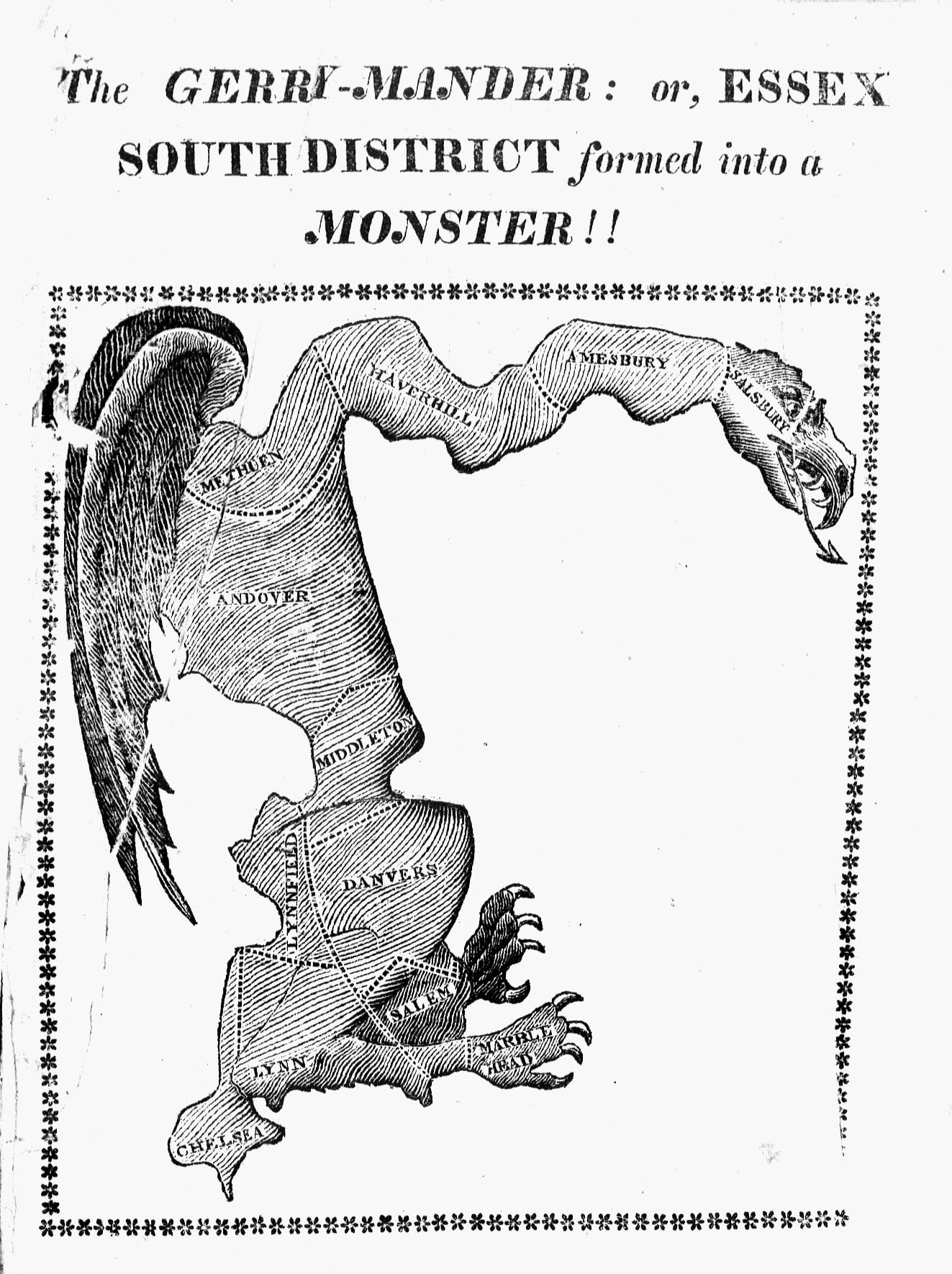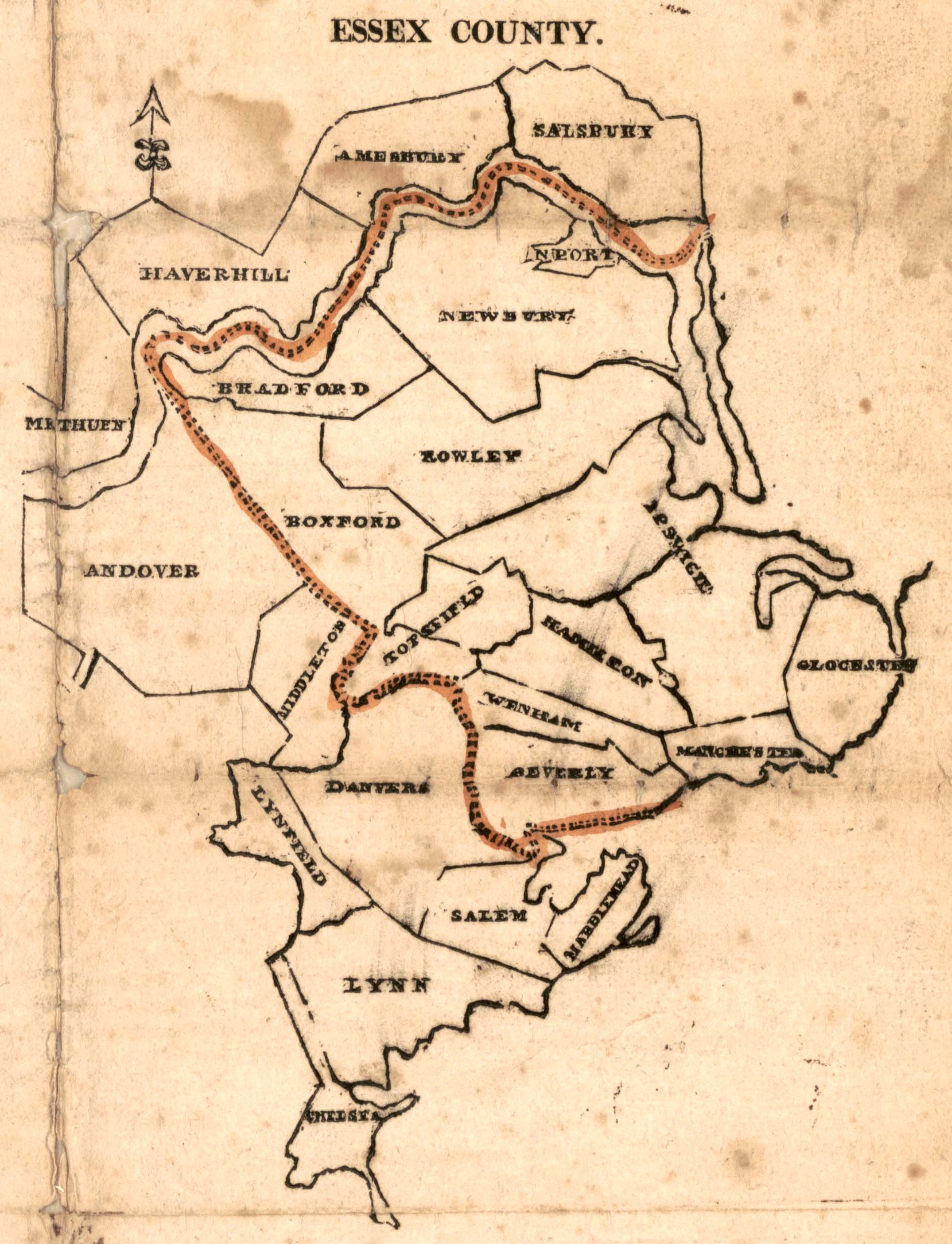gerrymander

Political jargon terms often have a short life. Terms terms such as to bork or hanging chad which once briefly dominated the news cycle are now historical footnotes. Gerrymander, however, is one of the most successful political jargon terms of all time, but its survival is somewhat unfair to its namesake, Elbridge Gerry (1744–1814), a signer of The Declaration of Independence, governor of Massachusetts, and vice president of the United States. To gerrymander is to draw a state’s voting districts in such a way as to give political advantage to one’s own political party, but Gerry was only reluctantly associated with the practice.
The U.S. Constitution requires a census be taken every ten years and that state legislatures redraw the districts from which U.S. representatives are elected to reflect changes in population. The legislatures of the several states define their districts in a similar manner. Of course, this creates lots of opportunities for political mischief or even outright corruption as each political party seeks to redraw the district boundaries to favor their own electoral chances.
The idea that one could fashion district boundaries to favor one side or the other is almost as old as the republic itself, and one of the early egregious examples of this practice occurred in 1812 in Essex County, Massachusetts. The Massachusetts legislature, dominated by Democratic-Republicans (the forerunner of the modern Democratic Party) drew one district so that it snaked around the outskirts of the county, favoring their party over the competition, the Federalists. Gerry, who was a Democratic-Republican and governor at the time, actually objected to the plan, but he signed it into law out of party loyalty, and by doing so, he became the public face of the convoluted district.

The Boston Gazette, a Federalist paper edited by John Russell, first reported on the redistricting plan in an extra edition on 9 March 1812, but it did not at first use the term gerrymander, instead referring to it as a “Crooked S,” “concave,” and “egg-shell district.” The extra edition published redistricting maps of Worcester and Essex Counties and said of them:
The above representation has been procured to show, so far as can be shown by the instances of two Counties only, in what mode the present ruling party have dissected the Commonwealth; “carved it as a dish fit for the Gods” but “hewn it as a carcase [sic] fit for hounds.”
[…]
The County of Essex has been divided into Districts, described by the dotted lines, to which the ingenious carvers have been unwilling to assign names. The District, of which the extremes are Salisbury, on the North side of the Merrimack River, and Chelsea (which last was cut off from Suffolk to prevent that District from sending six Senators) may be properly called by the name which children give to a letter in the alphabet, “Crooked S;” or one District may be denominated concave, and the other convex, as one of the fits into the other, very much as the half of a small egg may be put into half the shell of a larger egg.
[…]
By the new division it is expected, by the democratic legislators, the Worcester South District will send two senators of their party to the next legislature, and that three of the same description will be returned from the semicircular, crooked S, concave, or egg-shell district in Essex. If such should be the result, these counties, containing an immense federal majority of more than two thousand eight hundred electors, would exhibit the strange spectacle of being represented by four federalists and five democrats in the first branch of the legislature. But we confide in the spirit, the intelligence, and the virtue of the good people of these districts of [sic] defeat this attempt to control the constitutional right of suffrage.
Allegedly, one of the editors the Boston Gazette upon seeing the map compared the district to a salamander. In reply, another editor reportedly said, “Salamander! Call it a Gerrymander.” There is considerable doubt as to these details, however, and exactly who coined gerrymander is not known. The likeliest candidate is the Gazette’s editor, John Russell. Other candidates include Russell’s brother Benjamin, who edited the Federalist Columbian Centinel and who used the word the following month, and Nathan Hale, editor of the Boston Weekly Messenger, another Federalist newspaper, and nephew of the Revolutionary War patriot who had regretted he “had but one life to lose for his country.”
What we do know for certain is that the word gerrymander first appears in the pages of the Boston Gazette on 26 March 1812, accompanied by a political cartoon that depicted the snake-like district as a winged serpent. The drawing was probably a creation of engraver Elkanah Tisdale, and not painter Gilbert Stuart who is often given credit. The cartoon bore the headline of:
The Gerry-mander.
A new species of Monster, which appeared in the Essex South District in January last.
And the accompanying text read, in part:
From these premises the sagacious Doctor most solemnly avers there can be no doubt that this monster is a genuine Salamander, though by no means perfect in all its members; a circumstance however which goes far to prove its legitimacy. But as this creature has been engendered and brought forth under the sublimest auspices, he proposes that a name should be given to it, expressive of its genus, and at the same time conveying an elegant and very appropriate compliment to his Excellency the Governor, who is known to be the zealous patron and promoter of whatever is new, astonishing and erratic, especially of domestic growth and manufacture. For these reasons and for other valuable considerations, the Doctor has decreed that this monster shall be denominated a Gerry-mander, a name that must exceedingly gratify the parental bosom of our worthy Chief Magistrate, and prove so highly flattering to his ambition, that the Doctor may confidently expect in return for his ingenuity and fidelity, some benefits a little more substantial than the common reward of virtue.
The said “Doctor Watergruel” is a satirical invention of the Gazette’s editors.
The cartoon and the word gerrymander were reprinted in papers across Massachusetts and the United States. Thus a political term was born, the term became a Federalist rallying cry in the 1812 election, and Gerry lost his gubernatorial re-election bid because, at least in part, of it.
Gerry pronounced his name with a hard g (IPA: /g/) but over time the pronunciation of gerrymander shifted to a soft g (IPA: /dʒ/), probably because as Elbridge faded from memory (he would go on to the political oblivion that is the vice presidency of the United States*) people gave it the pronunciation of the first name Gerry or Jerry and perhaps with the influence of jerry-built, a term meaning of shoddy construction.
(* There is the old story of two brothers, one who went to sea and the other who became vice president. Neither were ever heard from again.)
Sources:
Davis, Jennifer. “Elbridge Gerry and the Monstrous Gerrymander.” In Custodia Legis: Law Librarians of Congress (blog), 10 February 2017.
“Essex County; Worcester County.” Boston Gazette, Extra 9 March 1812. Library of Congress.
“The Gerry-Mander: or, Essex South District Formed into a Monster!!” Newburyport Herald and Country Gazette, 31 March 1812, 5. Readex: America’s Historical Newspapers.
Oxford English Dictionary, second edition, 1989, s.v. gerrymander, n., gerrymander, v.
Tréguer, Pascal. “Why ‘Gerrymander’ Was Originally the Name of a Monstrous Salamader.” 3 November 2018, Wordhistories.net.
Image credits: Elkanah Tisdale, “The Gerry-Mander: or, Essex South District Formed into a Monster!!” Newburyport Herald and Country Gazette, 31 March 1812, public domain image; “Essex County; Worcester County.” Boston Gazette, Extra 9 March 1812, Library of Congress, Public domain image.